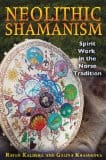 Neolithic Shamanism: Spirit Work in the Norse Tradition, by Raven Kaldera and Galina Krasskova
Neolithic Shamanism: Spirit Work in the Norse Tradition, by Raven Kaldera and Galina Krasskova
Destiny Books, 9781594774904, 342 pp. (incl. index, plus 8 pages of colour plates), 2012
The title, Neolithic Shamanism, may be a bit misleading as there is not a lot careful exploration of the stone age, but the sub-title, “Spirit Work in the Norse Tradition” seems closer to the subject of the book. The book instead serves as an introduction to the Northern Tradition – which the authors use to refer to a specific modern tradition, not simply the hearth cultures of Northern Europe and the modern practices derived from them. However, by looking at the natural rather than cultural aspects, they seem to be trying to go back to the bare bones of the matter. Regardless, much of the information is generalizable and the book can be read in this broader light, so long as the reader understands that this is not its primary purpose or intention.
The two authors do a lot of online writing, via website and blog. I imagine maintaining their own voice as a space for their thoughts alone can be very difficult when producing a lot of material online. The book is written in an engaging and accessible fashion, not unlike their online works. At times its black and white style may seem a bit fixed or doctrinaire. This book exhibits none of the self effacing litanies and apologetics so often used in neo-Pagan writing to placate the ego of the reader or overemphasize having made room for every other possible opinion. The book is a straightforward account of how the authors see the world, nothing more.
Beyond the introductory chapters to the book and the tradition, which should be read first, before reading any other chapters; there are chapters, in order, about: Earth, Sun, Moon, Plants, Animals, Water, Fire, Crafted items, Air, and Ancestors, and an epilogue on the nature of oaths, and relationship with the spirits in our world. The order of the chapters seems a bit random, but each chapter can, for the most part, stand on its own. Given the standalone quality of the chapters, and the well organized and comprehensive index, this book can be read cover to cover or browsed for information about a particular element or exercise.
Some of the information in this book is at odds with notions found in popular neo-Paganism, and the authors are quick to say as much. For example, the system has more than four elements, since each element is treated as an aspect of nature, rather than a pristine building block from which nature is constructed. Likewise, the Sun is depicted as feminine and the Moon as masculine. This actually is in line with the hearth cultures of Northern and Western Europe, when seen in their own light rather than through a Wiccan or neo-classical lens. Where there are historical precedents the authors say a bit about that, which is nice.
A few times in each chapter the book has a sort of anecdotal quality, as the authors share bits and pieces of their personal experience with the elements of the natural world. For example, in the ‘Red World’ chapter about relating to fire, they write about learning to make fire for themselves, how difficult that was, and what this taught them.
I really appreciate the frankness with which the authors describe the dangers of the natural world. They honestly convey the unpredictability of fire, the ferocious nature of vast bodies of water, or the behaviour of animals – which are viewed with a healthy respect for their intelligences, but are not anthropomorphised or made ‘cuddlier’ than they really are. This is something that is often forgotten (or flat-out misrepresented!) by some of our more romantic authors; especially those from countries where ‘wilderness’ has been reduced to safe pastoral environs where most dangers have long since been culled.
The elements are not refined moral powers, a fact which makes me wonder, and not for the first time, if perhaps morality is what beings more like us bring to the table; if so, we are failing. Regardless, this book affirms, both in general, and with its final statement, that the elemental powers all around us “can teach us again how to be in this world, not separated from it. We are not alone – we never were – and all we have to do is learn and listen.”1
- p.324 [↩]








